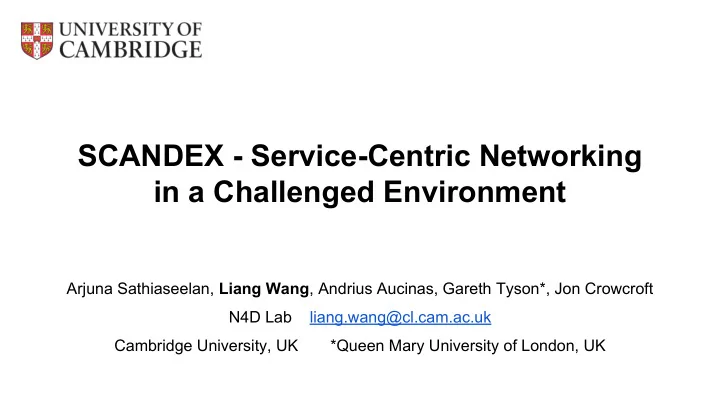

SCANDEX - Service-Centric Networking in a Challenged Environment Arjuna Sathiaseelan, Liang Wang , Andrius Aucinas, Gareth Tyson*, Jon Crowcroft N4D Lab liang.wang@cl.cam.ac.uk Cambridge University, UK *Queen Mary University of London, UK
Content ● Background - from content to service caching. ● Motivation - why do we need service caching? ● SCANDEX Description - behaviors, key components and etc. ● Challenges - service abstraction, synchronisation and etc. ● Conclusion
From Static Content to Dynamic Service ● Internet is for disseminating information efficiently. ● Our network architecture originates from P-to-P paradigm. ● What should be the next move on research agenda? ○ Information should not only refer to static content. ○ Recursive definition: Information = f (Information). ○ f is service which filters, edits, combines existing information to provide new information. ● Ideal Internet should be Information-Centric + Delay-Tolerant.
Real-life Needs for Service Caching ● Better localised communication: latency, bandwidth, availability … ● Better control on sharing conventional static content. ● Flexible policy configuration but with simpler architecture. ● Key services in emergency and disaster scenarios. ● Efficient access to popular Internet cloud-based services. Let’s push the services to network edge.
Challenges in A Challenged Environment ● From content to service - a ‘small’ but non-trivial step. ● Unpredictable nature of DIY networks. ● Which services should be migrated? ● When should they be migrated? ● Can cached services continue to operate without remote connectivity? ● How should state be managed?
SCANDEX - Key System Components ● Service Execution Gateway - executes services. ● Forwarding Node - forwards requests and caches services. ● Edge Gateway - interconnects different domains. ● Broker - service registration and resolution. ● Note multiple components can be multiplexed on one node.
A Utopia for Service-Centric Networking ● SCANDEX depicts a utopia of SCN.
System Features ● SCANDEX is a strawman architecture which describes how the system should behave instead of defining protocols. ● Everything is a service, including static content. ● System supports multiple transmission strategies: IP, DTN … ● System intelligently chooses the most suitable strategy.
Questions Instead of Solutions E.g., how to handle dynamics, predictability, cost, scalability, audit, and etc. More specifically, ● How to define edge? Network boxes or end-user devices? ● How to differentiate from NFV (network func virtualisation)? ● What naming scheme to use? Flat or hierarchical? ● How to do service resolution? I.e., registration & discovery.
Design Challenges - Synchronisation ● Abstraction: algo + data. In practice, what is it? ● Classification: computation vs. data intensive. ● Caching: singleton vs. multi-instance. ● Synchronisation: stateless vs. stateful. ○ Service-level synchronization semantics. ○ System is only responsible for coordination.
Design Challenges - Dependency ● A hard decision → atomic & meta vs. composition. ● Dependency is modelled as a DAG. ○ How many types of cost? Computation, traffic and etc. ○ Who should resolve the dependency?
Other Challenges ● Transmission strategy selection - topology- and context-aware? ● Distributed authentication - connection- or service-based? ● Service instantiation - where and how? ● Caching strategy - proactive or passive?
Summary ● Localised communication requires us to shift from content caching to service-caching. ● SCANDEX defines the high-level system behaviors. ● We defined the key system components and their functions. ● We presented design challenges such service abstraction, synchronisation, dependency, caching etc., and discussed the possible solutions
Thank you. Questions? … or … Solutions?
Recommend
More recommend